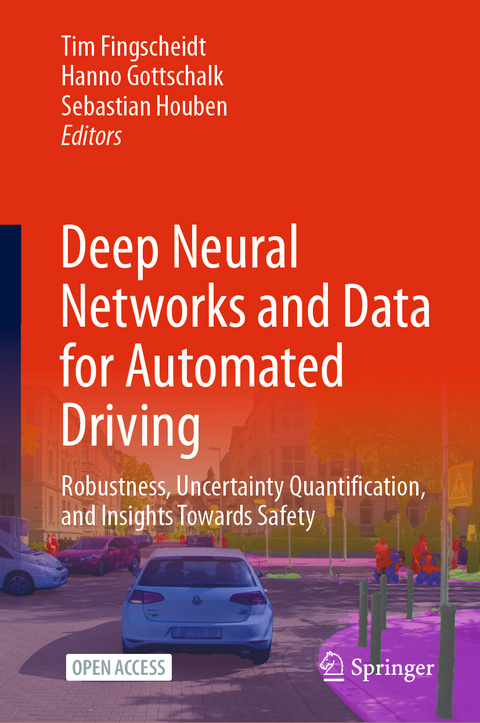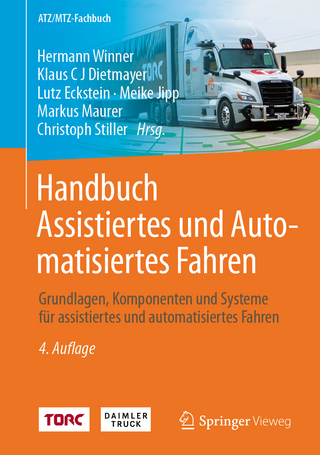
Deep Neural Networks and Data for Automated Driving
Springer International Publishing (Verlag)
978-3-031-01232-7 (ISBN)
This open access book brings together the latest developments from industry and research on automated driving and artificial intelligence.
Environment perception for highly automated driving heavily employs deep neural networks, facing many challenges. How much data do we need for training and testing? How to use synthetic data to save labeling costs for training? How do we increase robustness and decrease memory usage? For inevitably poor conditions: How do we know that the network is uncertain about its decisions? Can we understand a bit more about what actually happens inside neural networks? This leads to a very practical problem particularly for DNNs employed in automated driving: What are useful validation techniques and how about safety?
This book unites the views from both academia and industry, where computer vision and machine learning meet environment perception for highly automated driving. Naturally, aspects of data, robustness, uncertainty quantification, and,last but not least, safety are at the core of it. This book is unique: In its first part, an extended survey of all the relevant aspects is provided. The second part contains the detailed technical elaboration of the various questions mentioned above.Tim Fingscheidt received the Dipl.-Ing. degree in Electrical Engineering in 1993 and the Ph.D. degree in 1998 from RWTH Aachen University, Germany, both with distinction. He joined AT&T Labs, Florham Park, NJ, USA, for a PostDoc in 1998 and Siemens AG (Mobile Devices), Munich, Germany, in 1999, heading a signal processing development team. After a stay with Siemens Corporate Technology, Munich, Germany, from 2005 to 2006, he became Full Professor with the Institute for Communications Technology, Technische Universität (TU) Braunschweig, Germany, holding the Chair of "Signal Processing and Machine Learning". His research interests are machine learning in vision and time series such as speech, with focus on environment perception, signal classification, coding, and enhancement. He is founder of the TU Braunschweig Deep Learning Lab (tubs.DLL), a graduate student research thinks tank being active in publicly funded and industry research projects. Many of his projects have been dealing with automotive applications. Since 2018, he has been actively involved in the large-scale national research projects AI Platform Concept, AI Validation, AI Delta Learning, and AI Data Tooling, contributing research in robust semantic segmentation, monocular depth estimation, domain adaptation, corner case detection, and learned image coding. Prof. Fingscheidt received numerous national and international awards for his publications; among these, three CVPR workshop best paper awards in 2019, 2020, and 2021. He is interested in where academia meets industry and where machine learning meets highly automated driving.
Chapter 1. Inspect, Understand, Overcome: A Survey of Practical Methods for AI Safety.- Chapter 2. Does Redundancy in AI Perception Systems Help to Test for Super-Human Automated Driving Performance?.- Chapter 3. Analysis and Comparison of Datasets by Leveraging Data Distributions in Latent Spaces.- Chapter 4. Optimized Data Synthesis for DNN Training and Validation by Sensor Artifact Simulation.- Chapter 5. Improved DNN Robustness by Multi-Task Training With an Auxiliary Self-Supervised Task.- Chapter 6. Improving Transferability of Generated Universal Adversarial Perturbations for Image Classification and Segmentation.- Chapter 7. Invertible Neural Networks for Understanding Semantics of Invariances of CNN Representations.- Chapter 8. Confidence Calibration for Object Detection and Segmentation.- Chapter 9. Uncertainty Quantification for Object Detection: Output- and Gradient-based Approaches.- Chapter 10. Detecting and Learning the Unknown in Semantic Segmentation.- Chapter 11. Evaluating Mixture-of-Expert Architectures for Network Aggregation.- Chapter 12. Safety Assurance of Machine Learning for Perception Functions.- Chapter 13. A Variational Deep Synthesis Approach for Perception Validation.- Chapter 14. The Good and the Bad: Using Neuron Coverage as a DNN Validation Technique.- Chapter 15. Joint Optimization for DNN Model Compression and Corruption Robustness.
| Erscheinungsdatum | 22.06.2022 |
|---|---|
| Zusatzinfo | XVIII, 427 p. 117 illus., 103 illus. in color. |
| Verlagsort | Cham |
| Sprache | englisch |
| Maße | 155 x 235 mm |
| Gewicht | 834 g |
| Themenwelt | Technik ► Fahrzeugbau / Schiffbau |
| Technik ► Maschinenbau | |
| Schlagworte | Autonomous Driving • Deep learning • Environment Perception • Highly automated driving • open access • Safety |
| ISBN-10 | 3-031-01232-1 / 3031012321 |
| ISBN-13 | 978-3-031-01232-7 / 9783031012327 |
| Zustand | Neuware |
| Informationen gemäß Produktsicherheitsverordnung (GPSR) | |
| Haben Sie eine Frage zum Produkt? |
aus dem Bereich


